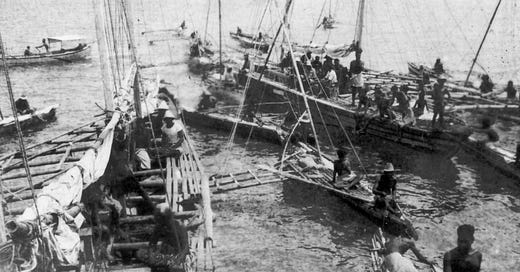Five days after leaving Suva they arrived off Niulakita at the southern end of Ellice Island group. Heenan’s notebook recorded ‘no natives, plenty fruit’. Heavy swells prevented a landing and the radio operator and two soldiers assigned there had to return two months later. The trip onward was delayed after a strong Morse signal was picked up and then identified as an American ship. Mullins had his doubts that such a ship was in that part of the world so diverted Viti away from where he thought the signal came from.
Viti arrived at Funafuti, the main island in the Ellice Group, on 24 July 1941, passing through the reef into the 170 square kilometre lagoon. John Jones thought it looked ‘real South Sea-ish…. Natives paddled their big canoes around our ship singing songs of welcome and that evening we were entertained in the village by the natives who put on their regalia and danced and sang for hours.’ While unloading went on, rugby was played between Viti’s crew and islanders. The crew won the rugby but the islanders knew cricket in the Polynesian version, kilikiti.
‘The bat is like a baseball bat and the ball was about half the size of our NZ one, also they have one wicket and it is surprising how quickly they can bowl anyone out,’ Heenan reported. ‘Runners are also supplied so all one needs to do is to bat. A team from the boat made 35. I made 8 runs, tied with another chap for top score. They made 175.’
Relay races were held with victory to the ship; a tug-of-war with a win to the island.
‘After that the Fijians and natives had a game of soccer. It ended in a draw but it was a very good game to watch.’
The sports day was rounded out with a dance and a haka from the New Zealanders: ‘just as good a day’s sport as anywhere in New Zealand.’
Keep reading with a 7-day free trial
Subscribe to Michael Field's South Pacific Tides to keep reading this post and get 7 days of free access to the full post archives.




